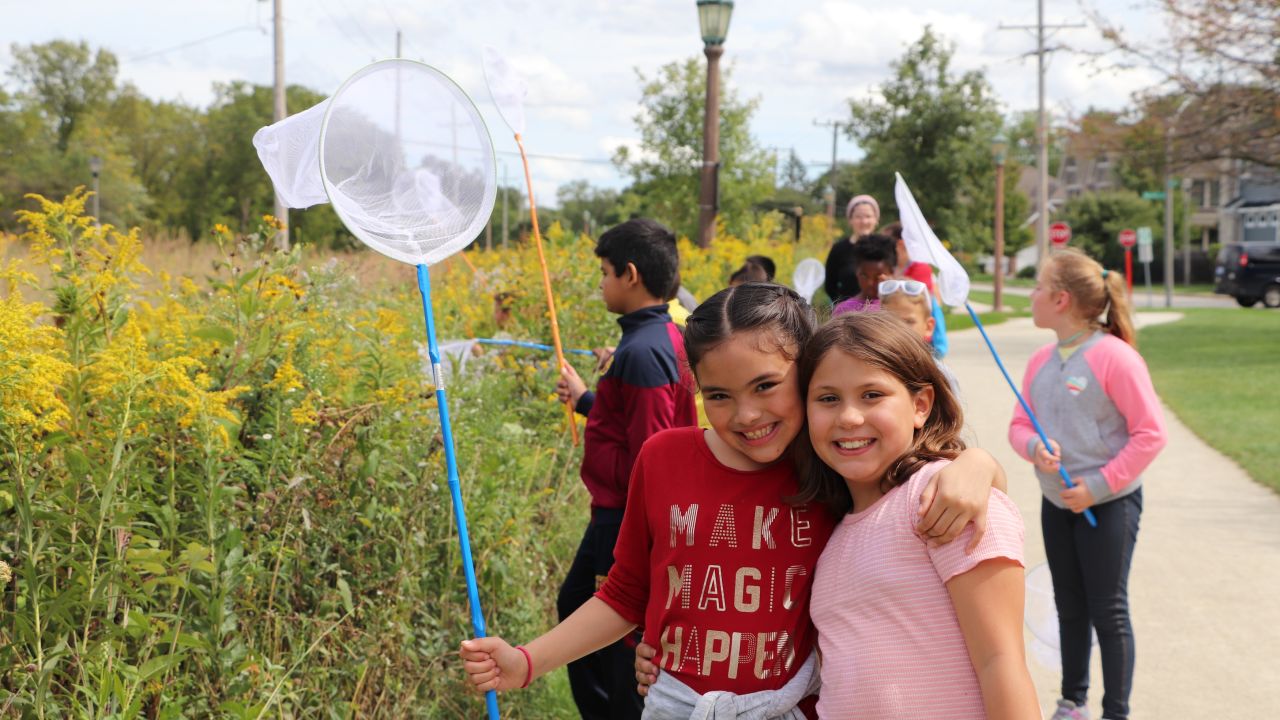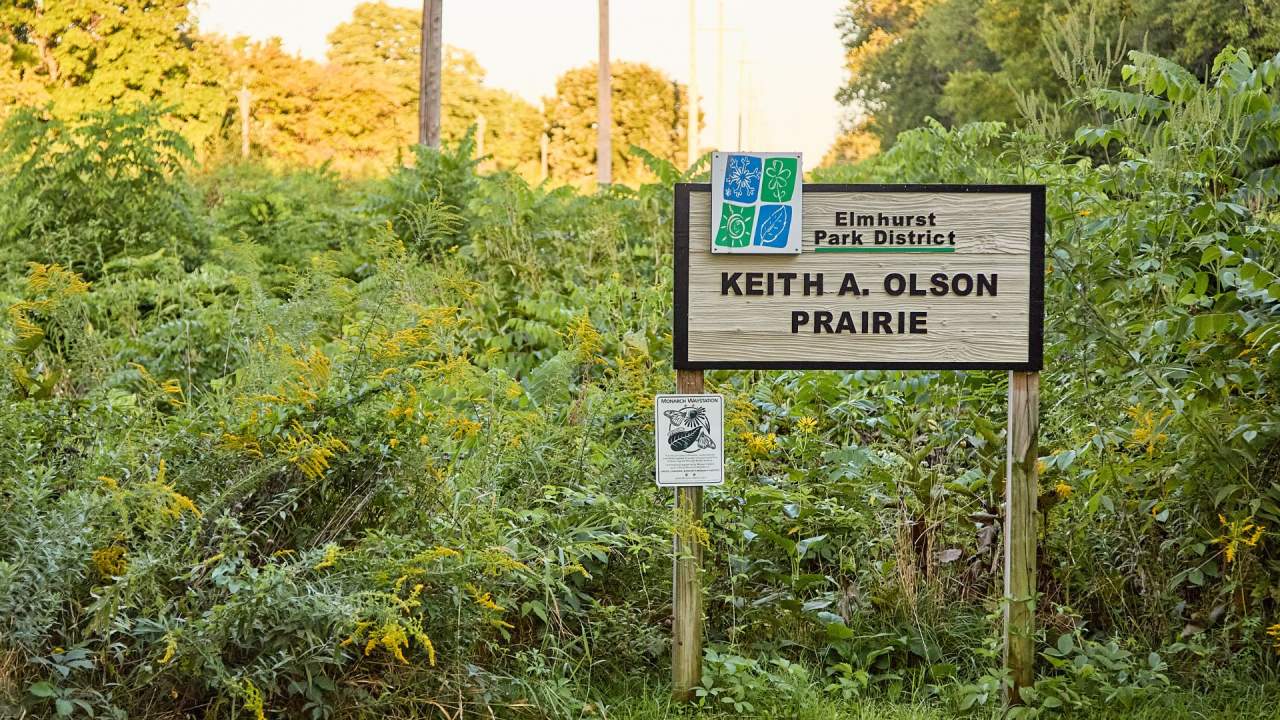The Keith A. Olson Prairie (formally the Elmhurst Great Western Prairie) is located within Wild Meadows Trace just north of the Prairie Path between Spring Road and Salt Creek. This area is the oldest living environment in Elmhurst. Left by chance, the existence of the prairie adds a very special ecological dimension to the community.
Volunteer Opportunities at the prairie
Join Elmhurst Park District in caring for the beautiful Keith A. Olson Prairie, the oldest living environment in Elmhurst! Volunteers engage in a variety of activities, including woody and invasive species removal, plant identification, restoration, trash collection and signage clearing. Volunteers must be at least 15 years of age.
Staff will meet volunteers at Wild Meadows Trace (496 Spring Road, at the corner of Spring Road and Prairie Path Lane). Meet staff in front of the Keith A. Olson Prairie sign on the west side of Spring Road adjacent to the municipal parking lot and Phase 3 Brewing Company.
Volunteer days are held on the 3rd Saturday of the month from 9am-Noon in February, March, April, September, October, and November. Contact the Horticulture Supervisor with questions or sign-up for specific days below.
Features & Amenities
History
Native prairie is a distinctive landscape which is rapidly disappearing from northeastern Illinois. The Keith A. Olson Prairie is one of only a few prairie remnants remaining along the length of the Illinois Prairie Path. The prairie is many things - a remnant of the pre-settlement landscape, a unique ecosystem that contains many special plants, a visual contrast to lawns and tree-lined streets, a living museum and a constant reminder that Illinois is "The Prairie State."
Location
Elmhurst's virgin prairie remnant is a six-acre strip adjacent to and north of the Illinois Prairie Path. The property is owned and maintained by the Elmhurst Park District. It is bound by Spring Road on the east; Salt Creek on the west; the abandoned right-of-way of the Chicago Great Western Railway on the north; and the abandoned right-of-way of the Chicago, Aurora and Elgin Railway (now known as the Illinois Prairie Path) on the south.
The History
What is the oldest thing in Elmhurst? It's not someone's home or a commercial building. Or even an early elm tree. It's a long strip of prairie, saved by accident and circumstance.
Before Elmhurst was founded in 1827, the Illinois landscape was mostly prairie, and the vistas had changed little for thousands of years. Even 50 years ago, much was still undisturbed. Today, the development of residential and commercial areas in our town have transformed the landscape, yet we are lucky to discover that "a piece of the past" still remains.
"Prairie" was the name given to the vast open lands which awed the French explorers when they first visited "The Illinois Country" in the seventeenth century. In French, "prairie" means meadow, the only word they had to describe our vast grasslands. The plants they saw were perennial native grasses and flowering plants. The only trees or woody plants at that time were along the edges of rivers, streams and ponds.
Once, most of the northern two-thirds of Illinois was prairie. Now far less than one percent of that original grassland remains. Elmhurst has a rare and unique opportunity to maintain and display a prairie in otherwise developed surroundings, thereby preserving a living time capsule of Illinois in its original state.
Prairie Preservation in Elmhurst
Interest in preserving the Keith A. Olson Prairie endures throughout the community due to a number of local conservationists who volunteer their time and expertise.
The Keith A. Olson Prairie is considered a "jewel of the Elmhurst Park District." To preserve this local treasure and ensure its future existence, a comprehensive management plan is being implemented to guide preservation and restoration efforts, to increase public awareness, and to ensure continued progress toward reestablishment of the historic appearance of the prairie.
Value of Natural Prairies
- As a landscape dominated by unknown grasses, it serves as visual contrast to lawns and tree-lined streets.
- As an example of prairie near the Prairie Path, it displays many native plants: shooting star, spiderwort and the nodding wild onion of spring and summer; the asters and coneflowers of late summer and fall; the compass plant with its tough leaves pointing north and south; the big bluestem and Indian grasses with their blades and flowers reaching overhead.
- It is a place in the midst of our schools and homes to teach preservation and the values of the natural world.
- One of the outstanding features of the prairie is its diversity. Every square yard is different from every other. It is an archetype of the world's ecosystems and their complexities.
- As a remnant of the pre settlement historical landscape and a living plant museum, this land is a nearby reminder that Illinois is the Prairie State.
Prairie Burns and Other Management Tools
In order to manage the prairie, the Elmhurst Prairie was first burned in 1977 and almost every year since. The burn is conducted by Elmhurst Park District staff. The original prairies were stable ecosystems maintained primarily by fire, set either by lightning strikes or by Native Americans driving game. Prairie fires, which sweep quickly over the ground, do not harm the deeply rooted prairie plants but destroy the bark and wood of the trees and shrubs which are not part of the prairie ecosystem. Fire renews the soil by returning nutrients in the form of ash. Prairie animals escape the fire by running, flying or retreating to their burrows. Within a few weeks after the burn, the well-established prairie plants begin to emerge from the ground once more.
Other prairie management practices include cutting woody growth and spreading high quality native seeds to add more kinds of plants to the varieties that have always been there. Seedlings started in the Elmhurst Park District greenhouse are planted each year to expand and enhance the native species already growing. Prairie plant growth and brush removal are also monitored.
Why Burn?
Before European settlement, prairies were the dominant landscape of Illinois for thousands of years. Fires, whether set by lightning or Native Americans, helped maintain the prairies. Sweeping across the landscape, the fires burn quickly through the dead growth from previous years. The living portion of the prairie plants is below ground, protected from harsh winters as well as fire.
- With a burn, the ground is opened up, stimulating new growth.
- With a burn, nutrients are returned to the soil, stimulating new growth.
- Without a burn, thatch builds up, suppressing some prairie plants
- Without a burn, shrubs and small trees spring up, choking out the prairie plants.
Why the name “Keith A. Olson Prairie”?
When founded, the prairie was named the Elmhurst Great Western Prairie. Two railroads, the Chicago Great Western and Chicago, Aurora, and Elgin ran parallel through Elmhurst. The prairie lies between the two, but more on the former right of way of the Great Western, and is the only place in the Western Suburbs with preserved native prairie. The land is controlled by the Elmhurst Park District as part of Wild Meadows Trace. The right of way of the Chicago, Aurora, and Elgin is now occupied by the Illinois Prairie Path.
The early Europeans saw a landscape very different from the present, and named it prairie, after the French word for meadow. Their observations, and the records of surveyors, documented that the northern two thirds of Illinois and all of DuPage County were primarily prairie. Those prairies are now the corn and soybean fields, towns, and housing developments.
In 2024, the prairie was renamed the Keith A. Olson Prairie to honor one of its biggest advocates and stewards. Over the course of nearly 50 years, Olson dedicated countless hours of volunteerism to the prairie.




